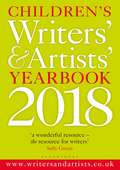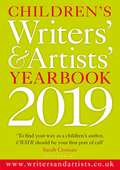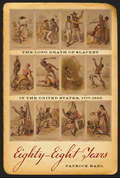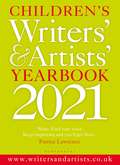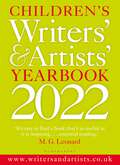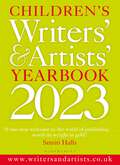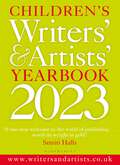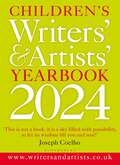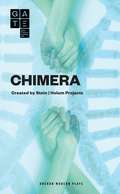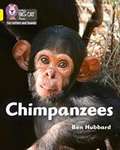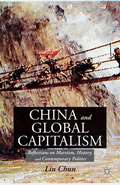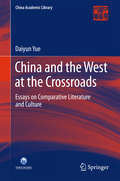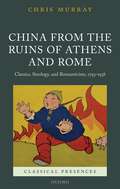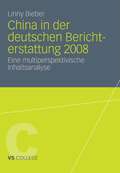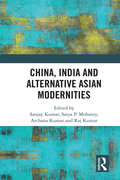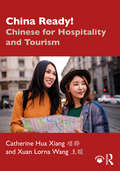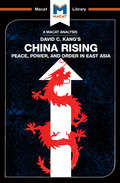- Table View
- List View
Children's Writers' & Artists' Yearbook 2018 (Writers' and Artists')
by Bloomsbury PublishingThe annual, bestselling guide to all aspects of the media and how to write and illustrate for children and young adults. Acknowledged by the media industries and authors as the essential guide to how to get published. The 70+ articles are updated and added to each year. Together they provide invaluable guidance on subjects such as series fiction, writing historical or funny books, preparing an illustration portfolio, managing your finances, interpreting publishers' contracts, self-publishing your work.Foreword by Sally Green, author of the award-winning YA fantasy trilogy: Half Bad (2014), Half Wild (2015) and Half Lost (2016). NEW articles for the 2018 edition on: - Writing for reluctant readers by Jon Mayhew- Writing for teenagers by Holly Smale- Choosing the right agent by Gill McLay or the Bath Literary Agency- Plotting: getting started with your YA novel by Sarah Mussi - Writing adventures in the real world: children's non-fiction by Isabel Thomas All of the 2,000 listings of who to contact across the media have been reviewed and updated. The essential guide for any writer for children.
Children's Writers' & Artists' Yearbook 2019 (Writers' and Artists')
by Bloomsbury PublishingThe annual, bestselling guide to all aspects of the media and how to write and illustrate for children and young adults. Acknowledged by the media industries and authors as the essential guide to how to get published. The 70+ articles are updated and added to each year. Together they provide invaluable guidance on subjects such as series fiction, writing historical or funny books, preparing an illustration portfolio, managing your finances, interpreting publishers' contracts, self-publishing your work.Foreword by Sarah Crossan, Carnegie Medal winner and author of One, Breathe, Moonrise (published July 2018) and We Come Apart (with Brian Conaghan) NEW articles for the 2019 edition include: LGBT+ characters in children's fiction by Lauren JamesThe hybrid author by Shelli R. Johannes A jobbing writer's lot by Joanna NadinAdapting children's books for stage and screen by Emma ReevesWhere does your book sit? by Jasmine RichardsMurderous inventions by Robin StevensThe long and winding road to publication by Paul StewartWriting picture books by Tessa StricklandThe ups and downs of being a writer by Theresa Tomlinson All of the 2,000 listings of who to contact across the media have been reviewed and updated. The essential guide for any writer for children.
Children's Writers' & Artists' Yearbook 2020: Improvisation And The Theatre (Writers' and Artists')
by Bloomsbury PublishingForeword by William Sutcliffe, author of Are you Experienced?, New Boy and We See EverythingThe indispensable guide to writing for children and young adults, this Yearbook provides inspirational articles from successful writers and illustrators, as well as practical advice on who to contact across the media and how to get published.New articles for the 2020 edition include:- Davinia Andrew-Lynch A message for under-represented writers: We Want You- Clémentine Beauvais Writing and translating children's fiction- Holly Bourne Dealing with tough issues in YA fiction- Natasha Farrant Writing about love and loss for children- Kiran Millwood Hargrave Writing magic into fiction- Salvatore Rubbino The craft of the illustrator- Deirdre Sullivan Reinventing old stories for new readers
Children's Writers' & Artists' Yearbook 2021 (Writers' and Artists')
by Bloomsbury PublishingPacked full of inspirational articles from successful writers, illustrators and publishing experts, the Children's Writers' & Artists' Yearbook once again serves up the best independent advice to writers for children of all ages. Covering all aspects of the publishing process, across the full range of formats and genres, it will appeal to self-published writers as well as those seeking an agent-publisher or crowdfunded deal. Inside are up-to-date contact details for literary agents, publishers, prizes and grant-giving bodies, societies and creative organisations that support writers and illustrators.Universally recognised as the first port of call for all writers wanting to improve their work and their chances of getting published, this Yearbook contains an 'impressive raft of advice and notes on every aspect of the business' (Quentin Blake).
Children’s Writers’ & Artists’ Yearbook 2022 (Writers' and Artists')
by Bloomsbury PublishingForeword by M. G. Leonard: 'It's rare to find a book that's as useful as it is inspiring ... essential reading.'The indispensable guide to writing for children and young adults, this Yearbook provides inspirational articles from successful writers and illustrators, as well as details on who to contact across the media. It provides practical advice on all stages of the writing process from getting started, writing for different markets and genres, through to submission to literary agents and publishers as well as on the financial and legal aspects of being a writer. Widely recognised as the essential support for authors and illustrators working across all forms: fiction, non-fiction, poetry, screen and theatre, it is equally relevant to those wishing to self-publish as well as those seeking a traditional publisher-agent deal.New articles for 2022:Christopher Edge Plotting and pace in your middle-grade adventureL. D. Lapinski World-building in your fantasy fictionAnna Wilson Finding your voice and point of viewRachel Bladon The learning curve: writing for the children's educational marketJenny Bowman How to hire a freelance editorSophie Clarke The life and works of a literary scoutRachel Rooney Writing poetry for children
Children's Writers' & Artists' Yearbook 2023 (Writers' and Artists')
by Bloomsbury PublishingForeword by award-winning illustrator Smriti Prasadam-Halls.The indispensable guide to writing for children of all ages from pre-school to young adults, this Yearbook provides inspirational articles from dozens of successful writers and illustrators on how to get your work published. It includes a directory of over a thousand up-to-date listings with contacts from across the media and publishing industry. This bestselling Yearbook is full of practical advice on all stages of the writing and illustration process from getting started, writing for different markets and genres, and preparing an illustration portfolio, through to submission to literary agents and publishers. It also covers the financial, contractual and legal aspects of being a writer and illustrator. Widely recognised as the essential support for authors and illustrators working across all forms: fiction, non-fiction, poetry, screen, audio and theatre, it is equally relevant to those wishing to self-publish as well as those seeking a traditional publisher-agent deal.It includes advice from best-selling writers, such as Sarah Crossan, Kiran Millwood Hargrave, Frances Hardinge, Tom Palmer, David Wood, Lauren Child and many more.Additional articles, free advice, events information and editorial services at www.writersandartists.co.uk
Children's Writers' & Artists' Yearbook 2023 (Writers' and Artists')
by Bloomsbury PublishingForeword by award-winning illustrator Smriti Prasadam-Halls.The indispensable guide to writing for children of all ages from pre-school to young adults, this Yearbook provides inspirational articles from dozens of successful writers and illustrators on how to get your work published. It includes a directory of over a thousand up-to-date listings with contacts from across the media and publishing industry. This bestselling Yearbook is full of practical advice on all stages of the writing and illustration process from getting started, writing for different markets and genres, and preparing an illustration portfolio, through to submission to literary agents and publishers. It also covers the financial, contractual and legal aspects of being a writer and illustrator. Widely recognised as the essential support for authors and illustrators working across all forms: fiction, non-fiction, poetry, screen, audio and theatre, it is equally relevant to those wishing to self-publish as well as those seeking a traditional publisher-agent deal.It includes advice from bestselling writers, such as Sarah Crossan, Kiran Millwood Hargrave, Tom Palmer, David Wood and many more.Additional articles, free advice, events information and editorial services at www.writersandartists.co.uk
Children's Writers' & Artists' Yearbook 2024: The best advice on writing and publishing for children (Writers' and Artists')
by Bloomsbury Publishing'A one-stop welcome to the world of publishing ... worth its weight in gold.' Smriti HallsOver the last two decades the Children's Writers' & Artists' Yearbook has become the indispensable guide to writing for children of all ages from pre-school to young adults.It is an essential item for any bookshelf, it includes advice, tips and inspiration for authors and illustrators working across all forms: fiction, non-fiction, poetry, screen, audio and theatre and magazines. It also covers the financial, contractual, and legal aspects of being a writer and illustrator.Its directory of 1,200 listings with contacts are updated yearly to provide the most up-to-date information across the media and publishing industry. It also includes over 50 articles by award-winning writers and illustrators covering all stages of the writing and illustration process from getting started, writing for different markets and genres, and preparing an illustration portfolio, through to submission to literary agents and publishers. Additional articles, free advice, events information and editorial services at www.writersandartists.co.uk
Children's Writers' & Artists' Yearbook 2024: The best advice on writing and publishing for children (Writers' and Artists')
by Bloomsbury Publishing'A one-stop welcome to the world of publishing ... worth its weight in gold.' Smriti HallsOver the last two decades the Children's Writers' & Artists' Yearbook has become the indispensable guide to writing for children of all ages from pre-school to young adults.It is an essential item for any bookshelf, it includes advice, tips and inspiration for authors and illustrators working across all forms: fiction, non-fiction, poetry, screen, audio and theatre and magazines. It also covers the financial, contractual, and legal aspects of being a writer and illustrator.Its directory of 1,200 listings with contacts are updated yearly to provide the most up-to-date information across the media and publishing industry. It also includes over 50 articles by award-winning writers and illustrators covering all stages of the writing and illustration process from getting started, writing for different markets and genres, and preparing an illustration portfolio, through to submission to literary agents and publishers. Additional articles, free advice, events information and editorial services at www.writersandartists.co.uk
Children's Writers' & Artists' Yearbook 2025: The best advice on writing and publishing for children (Writers' and Artists')
by Bloomsbury PublishingForeword by Alice Oseman, creator of the million-copy bestselling Heartstopper books.'This is not a book, it is a sky filled with possibility, so let its wisdom lift you and soar!' Joseph Coelho, Children's LaureateCelebrating its 21st edition, this indispensable Children's Writers' & Artists' Yearbook provides everything you need to know to get your work noticed. With thousands of up-to-date contacts and inspiring articles from dozens of successful writers, illustrators and industry insiders, it is the ultimate resource on writing and publishing for children of all ages.Packed with insights and practical tips, it provides expert advice on: - submitting to agents and publishers - writing non-fiction and fiction across genres and formats - poetry, plays, broadcast media and illustration - self-publishing - copyright, finances and contracts - marketing, prizes and festivals - and much, much more ...New content in this edition include articles on Your Author Brand by Tom Palmer, Getting Published by Hannah Gold, Writing with empathy by Camilla Chester, What an indie bookshop can offer authors by Carrie & Tim Morris.'Between the covers of this book is everything you need to know to get published.' Julia Donaldson
Children's Writers' & Artists' Yearbook 2025: The best advice on writing and publishing for children (Writers' and Artists')
by Bloomsbury PublishingForeword by Alice Oseman, creator of the million-copy bestselling Heartstopper books.'This is not a book, it is a sky filled with possibility, so let its wisdom lift you and soar!' Joseph Coelho, Children's LaureateCelebrating its 21st edition, this indispensable Children's Writers' & Artists' Yearbook provides everything you need to know to get your work noticed. With thousands of up-to-date contacts and inspiring articles from dozens of successful writers, illustrators and industry insiders, it is the ultimate resource on writing and publishing for children of all ages.Packed with insights and practical tips, it provides expert advice on: - submitting to agents and publishers - writing non-fiction and fiction across genres and formats - poetry, plays, broadcast media and illustration - self-publishing - copyright, finances and contracts - marketing, prizes and festivals - and much, much more ...New content in this edition include articles on Your Author Brand by Tom Palmer, Getting Published by Hannah Gold, Writing with empathy by Camilla Chester, What an indie bookshop can offer authors by Carrie & Tim Morris.'Between the covers of this book is everything you need to know to get published.' Julia Donaldson
Chimera (Oberon Modern Plays)
by Deborah Stein Suli HolumWhat would you do if you discovered you were your own twin? If you learned that your DNA did not quite belong to you? Welcome to Jennifer Samuels’ world. When she learns that she has inherited a rare medical condition her whole sense of self – biological, psychological, emotional, begins to unravel. Join Jennifer as she tumbles down the rabbit hole in a story that combines pin-point wit with breathtaking visuals. Taking its inspiration from real science, Chimera is a frightening, funny, and fascinating ride, coming to the Gate following a critically acclaimed run at the Public Theater’s Under the Radar Festival in New York.
Chimpanzees: Band 3 Yellow (PDF) (Collins Big Cat Phonics For Letters And Sounds Ser.)
by Ben HubbardCollins Big Cat Phonics for Letters and Sounds features exciting fiction and non-fiction decodable readers to enthuse and inspire children. They are fully aligned to Letters and Sounds Phases 1-6 and contain notes in the back. The Handbooks provide support in demonstration and modelling, monitoring comprehension and expanding vocabulary. Learn all about chimpanzees, from where they live to what they eat, in this photographic non-fiction book. Yellow/Band 3 books offer varied sentence structure and natural language This book focuses on adjacent consonants with short vowel phonemes. Pages 14 and 15 allow children to re-visit the content of the book, supporting comprehension skills, vocabulary development and recall. Reading notes within the book provide practical support for reading Big Cat Phonics for Letters and Sounds with children, including a list of all the sounds and words that the book will cover.
China and Global Capitalism: Reflections on Marxism, History, and Contemporary Politics
by L. ChunIn this concise historical and conceptual analysis of China's evolving position in a world defined predominantly by global capitalist development, Lin offers a critical review of relevant debates and discusses the imperative and feasibility of a socialist Chinese model, reconstructed, as an alternative to standardized modernity at an impasse.
China and the West at the Crossroads: Essays on Comparative Literature and Culture (China Academic Library)
by Daiyun YueBeginning with a retrospective of the past century, this book offers a panoramic picture of Chinese comparative literature, from its nascence in the early 1920s, through its evolution in the 1980s, to the new development at the turn of the century, ending with a prospective look at the future of comparative literature in the 21st century. The articles presented here reveal the author’s deep understandings of the literature and culture of her own country and those of other countries. A rich array of case studies and in-depth theorizing make it an extremely interesting and enlightening read.Prof. Daiyun Yue is a prominent professor at Peking University and a leading figure in Chinese comparative literature. She has served as Head of the Institute for Comparative Literature and Cultural Studies, PKU (1984—1998) and the third president of the Chinese Comparative Literature Association (1989—2014). Further, she is the founder of Dialogue Transculturel, a much-acclaimed journal of comparative literature.Prof. Yue approaches outstanding literature as a bridge to link people of different cultural traditions: “The reason why interdisciplinary literary research between two alien cultures is possible is because dialog between alien cultures, along with exchange and understanding, is more readily realized through literature.” Herein lies the value of comparative literature.
China English in World Englishes: Education and Use in the Professional World (Asia in Transition #10)
by Deyuan HeThis book fills the gap in World Englishes studies in terms of the pedagogic implication of China English and its use in the Chinese workplace. Using three triangulated methods, namely, questionnaire survey, matched-guise technique, and focused interview, the book adopts an innovative research methodology that combines quantitative and qualitative data from 3,493 participants. Overall, the participants still believe that the standardized Englishes are desirable models of English in China and that China English should be well codified and promoted before being adopted as the pedagogic model. In addition, the book proposes that the curriculum design of university English should include an introduction to the well-defined characteristics of China English and world Englishes. Last but not least, the book reveals that English is being used more widely and frequently in the professional world than before and has become increasingly important in China.
China from the Ruins of Athens and Rome: Classics, Sinology, and Romanticism, 1793-1938 (Classical Presences)
by Chris MurrayFascinated and often baffled by China, Anglophone writers turned to classics for answers. In poetry, essays, and travel narratives, ancient Greece and Rome lent interpretative paradigms and narrative shape to Britain's information on the Middle Kingdom. While memoirists of the diplomatic missions in 1793 and 1816 used classical ideas to introduce Chinese concepts, Roman history held ominous precedents for Sino-British relations according to Edward Gibbon and Samuel Taylor Coleridge. John Keats illuminated how peculiar such contemporary processes of Orientalist knowledge-formation were. In Britain, popular opinion on Chinese culture wavered during the nineteenth century, as Charles Lamb and Joanna Baillie demonstrated in ekphrastic responses to chinoiserie. A former reverence for China yielded gradually to hostility, and the classical inheritance informed a national identity-crisis over whether Britain's treatment of China was civilized or barbaric. Amidst this uncertainty, the melancholy conclusion to Virgil's Aeneid became the master-text for discussion of British conduct at the Summer Palace in 1860. Yet if Rome was to be the model for the British Empire, Tennyson, Sara Coleridge, and Thomas de Quincey found closer analogues for the Opium Wars in Greek tragedy and Homeric epic. Meanwhile, Sinology advanced considerably during the Victorian age. Britain broadened its horizons by interrogating the cultural past anew as it turned to Asia; Anglophone readers were cosmopolitans in time as well as space, aggregating knowledge of Periclean Athens, imperial Rome, and many other polities in their encounters with Qing Dynasty China.
China from the Ruins of Athens and Rome: Classics, Sinology, and Romanticism, 1793-1938 (Classical Presences)
by Chris MurrayFascinated and often baffled by China, Anglophone writers turned to classics for answers. In poetry, essays, and travel narratives, ancient Greece and Rome lent interpretative paradigms and narrative shape to Britain's information on the Middle Kingdom. While memoirists of the diplomatic missions in 1793 and 1816 used classical ideas to introduce Chinese concepts, Roman history held ominous precedents for Sino-British relations according to Edward Gibbon and Samuel Taylor Coleridge. John Keats illuminated how peculiar such contemporary processes of Orientalist knowledge-formation were. In Britain, popular opinion on Chinese culture wavered during the nineteenth century, as Charles Lamb and Joanna Baillie demonstrated in ekphrastic responses to chinoiserie. A former reverence for China yielded gradually to hostility, and the classical inheritance informed a national identity-crisis over whether Britain's treatment of China was civilized or barbaric. Amidst this uncertainty, the melancholy conclusion to Virgil's Aeneid became the master-text for discussion of British conduct at the Summer Palace in 1860. Yet if Rome was to be the model for the British Empire, Tennyson, Sara Coleridge, and Thomas de Quincey found closer analogues for the Opium Wars in Greek tragedy and Homeric epic. Meanwhile, Sinology advanced considerably during the Victorian age. Britain broadened its horizons by interrogating the cultural past anew as it turned to Asia; Anglophone readers were cosmopolitans in time as well as space, aggregating knowledge of Periclean Athens, imperial Rome, and many other polities in their encounters with Qing Dynasty China.
China in der deutschen Berichterstattung 2008: Eine multiperspektivische Inhaltsanalyse (VS College)
by Linny BieberChina, India and Alternative Asian Modernities
by Kumar Sanjay Satya P. Mohanty Archana Kumar Raj KumarThe conception of modernity as a radical rupture from the past runs parallel to the conception of Europe as the primary locus of global history. The essays in this volume contest the temporal and spatial divisions—between past and present, modernity and tradition, and Europe’s progress and Asia’s stasis—which the conventional narrative of modernity creates. Drawing on early modern Chinese and Indian history and culture instead, the authors of the book explore the provenance of modernity beyond the west to see it in a transcultural and pluralistic light. The central argument of this volume is that modernity does not have a singular core or essence—a causal centre. Its key features need to be disaggregated and new configurations and combinations imagined. By studying the Bhakti movement, Confucian democracy, and the maritime and agrarian economies of China and India, this book enlarges the terms of debate and revisits devalued terms and concepts like tradition, religion, authority, and rural as resources for modernity. This book will be of great interest to researchers and academicians working in the areas of history, Sociology, Cultural Studies, literature, geopolitics, South Asian and East Asian Studies.
China, India and Alternative Asian Modernities
by Kumar Sanjay Satya P. Mohanty Archana Kumar Raj KumarThe conception of modernity as a radical rupture from the past runs parallel to the conception of Europe as the primary locus of global history. The essays in this volume contest the temporal and spatial divisions—between past and present, modernity and tradition, and Europe’s progress and Asia’s stasis—which the conventional narrative of modernity creates. Drawing on early modern Chinese and Indian history and culture instead, the authors of the book explore the provenance of modernity beyond the west to see it in a transcultural and pluralistic light. The central argument of this volume is that modernity does not have a singular core or essence—a causal centre. Its key features need to be disaggregated and new configurations and combinations imagined. By studying the Bhakti movement, Confucian democracy, and the maritime and agrarian economies of China and India, this book enlarges the terms of debate and revisits devalued terms and concepts like tradition, religion, authority, and rural as resources for modernity. This book will be of great interest to researchers and academicians working in the areas of history, Sociology, Cultural Studies, literature, geopolitics, South Asian and East Asian Studies.
The China Mystique: Pearl S. Buck, Anna May Wong, Mayling Soong, And The Transformation Of American Orientalism
by Karen J. LeongThroughout the history of the United States, images of China have populated the American imagination. Always in flux, these images shift rapidly, as they did during the early decades of the twentieth century. In this erudite and original study, Karen J. Leong explores the gendering of American orientalism during the 1930s and 1940s. Focusing on three women who were popularly and publicly associated with China—Pearl S. Buck, Anna May Wong, and Mayling Soong—Leong shows how each negotiated what it meant to be American, Chinese American, and Chinese against the backdrop of changes in the United States as a national community and as an international power. The China Mystique illustrates how each of these women encountered the possibilities as well as the limitations of transnational status in attempting to shape her own opportunities. During these two decades, each woman enjoyed expanding visibility due to an increasingly global mass culture, rising nationalism in Asia, the emergence of the United States from the shadows of imperialism to world power, and the more assertive participation of women in civic and consumer culture.
China Ready!: Chinese for Hospitality and Tourism
by Catherine Hua Xiang Xuan Lorna WangChina Ready! prepares students and independent learners to work in the hospitality and tourism industry for high-value tourism business coming from China to English-speaking countries. The book focuses on listening and speaking skills – essential skills for learners. This book’s features include the following: • Important cultural and social awareness factors for interacting with clients from China • Vocabulary • Real-life scenarios • Situational role playing and interactive listening • Experiential exercises to encourage learning outside the classroom The book is aimed at students who have attained the Common European Framework Reference (CEFR) A2 level and will bring them up to the CEFR B2/C1 level or 汉语水平 考试 (HSK) 4/5.
China Ready!: Chinese for Hospitality and Tourism
by Catherine Hua Xiang Xuan Lorna WangChina Ready! prepares students and independent learners to work in the hospitality and tourism industry for high-value tourism business coming from China to English-speaking countries. The book focuses on listening and speaking skills – essential skills for learners. This book’s features include the following: • Important cultural and social awareness factors for interacting with clients from China • Vocabulary • Real-life scenarios • Situational role playing and interactive listening • Experiential exercises to encourage learning outside the classroom The book is aimed at students who have attained the Common European Framework Reference (CEFR) A2 level and will bring them up to the CEFR B2/C1 level or 汉语水平 考试 (HSK) 4/5.
China Rising: Peace, Power and Order in East Asia (The Macat Library)
by Matteo Dian Jason XidiasA critical analysis of David C. Kang’s China Rising, which is a fine example of an author making use of creative thinking skills to reach a conclusion that flies in the face of traditional thinking. The conventional view that the book opposed, known in international relations as ‘realism,’ was that the rise of any new global power results in global or regional instability. As such, China’s development as a world economic powerhouse worried mainstream western geopolitical scholars, whose concerns were based on the realist assumption that individual countries will inevitably compete for dominance. Evaluating these arguments, and finding both their relevance and adequacy wanting, Kang instead turned traditional thinking on its head by looking at Asian history without preconceptions, and with analytical open-mindedness. Producing several novel explanations for existing evidence, Kang concludes that China’s neighbors do not want to compete with it in the way that realist interpretations predict. Rather than creating instability by jockeying for position, he argues, surrounding countries are happy for China to be acknowledged as a leader, believing that its dominant position will stabilize Asia, and give the whole region more of a hand in international relations. Though critics have taken issue with Kang’s conclusions, his paradigm-shifting approach is nevertheless an excellent example of developing fresh new conclusions through creative thinking.
